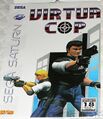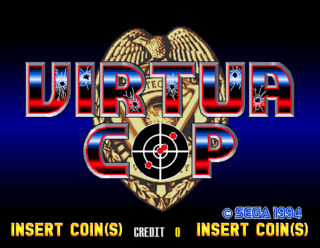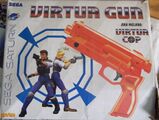Virtua Cop (バーチャコップ) is an arcade shooter game created by Sega AM2 for Sega Model 2 hardware in 1994. It is the first in the Virtua Cop series. It was one of the first light-gun games to take place in a 3D world, as the first light-gun shooter to use 3D polygons. Sega advertised it as the "world's first texture mapped, polygon action game". [2]
Virtua Cop's arcade success meant it was ported to the Sega Saturn in 1995 and later to PC in 1997. The Saturn version of the game was initially bundled with the Virtua Gun, a light-gun peripheral intended for use with this game. If the user lacks a CRT television, the Virtua Gun cannot be used, and the game must be played with the normal Saturn controller. The PC version uses the mouse, and was released in North America as "Virtua Squad".
Virtua Cop was followed by two sequels, Virtua Cop 2 and Virtua Cop 3. It was bundled Virtua Cop 2 in Japan and Europe on the PlayStation 2 as Virtua Cop: Elite Edition (Virtua Cop Rebirth in Japan) on August 25, 2002 and November 29, 2002 respectively. The "Elite Edition" includes gallery extras and implementation of Namco's G-Con 2 lightgun support.
In 2004, a port was developed for the handheld Nokia N-Gage, but was cancelled by the quality control team before its release. There are very few beta units in existence.
The PC version was known as Virtua City PD during development (at least, in North America, where it would eventually be known as Virtua Squad).
Story
A detective in the player's department uncovered an illegal gun-running operation and was able to trace it back to E.V.L Inc., a powerful crime syndicate. He compiled a large amount of evidence and was ready to take them down, but was soon discovered and assassinated by the criminals. Some of his evidence managed to make its way back to headquarters, and a special task force was put on the case. The policemen Michael Hardy and James Cools must face that organization led by Joe Fang and his followers Kong, the King, and the Boss.
Gameplay
Players assume the role of a police officer - either Michael Hardy, or his partner, James Cools. Played from a first person perspective view, the players must use the light gun to take down the multitude of sharp shooters who come for them. At the start of the game, the player is armed with only a pistol, but more powerful weapons, such as machine guns and shotguns, can be obtained as they progress. These weapons are hidden in breakable objects such as crates, and can be extremely useful when trying to take on the customary end-of-level bosses. There are penalties for shooting civilians. Virtua Cop was notable for its use of polygonal graphics, which were subsequently used in both House of the Dead and Time Crisis, instead of the two dimensional sprites that were popular for previous games in the same genre. It is also notable for being one of the first games to allow the player to shoot through glass. The game's realistic graphics earned it the "Virtua" title, along with other 3D Sega games such as Virtua Fighter, Virtua Striker and Virtua Racing.
History
Release
300,000 copies of Virtua Cop were sold in Japan during its first week[3].
Legacy
Virtua Cop revolutionized the light-gun shooter genre with its new 3D first-person rail shooter format, including new mechanics like positional body targeting and headshots, revitalizing the genre in the arcades. It also broke new ground by popularizing the use of 3D graphics in shooter games.[4] It inspired 3D light gun shooters such as Time Crisis and The House of the Dead as well as 3D first-person shooters such as GoldenEye 007,[5] which in turn laid the foundations for console FPS games.
Production credits
Arcade version
Main Programmer and Director: Katsunori Itai
Main Designer: Akihito Hiroyosi
2nd Programmer: Shunsuke Sekikawa
Programmers: Masayuki Sumi, Tadanobu Numata
Designers: Masataka Auchi, Saori Nisikawa
Sound Composer: Kentaro Koyama
Design Support: Kazuhiro Izaki, Yukinobu Arikawa, Makoto Osaki
Planning Support: Yuichiro Mikami
Cabinet Design: AM R and D Dept 4
Producer: Yu Suzuki[6]
Supervisor: Yu Suzuki
Presented by: Sega
Saturn version
- ~In-game credits~[7]
Director: Takashi Isono
Main programmer: Masayuki Sumi
Programmers: Takeshi Iwasaki, Jun-ichi Ishito, Takashi Isowaki
Programmers: Norihiro Sekine, Takashi Ono, Hiroyuki Tsuzuki
Designers: Takafumi Kagaya, Kazufumi Ohashi, Saori Nishikawa, Masakazu Takizawa
Sound Composer: Kentaro Koyama
Publicity: Fumio Kurokawa, Koji Umeda
Special Thanks: Yukinobu Arikawa, Masataka Aochi, Kazuo Ohtani
Supervisor: Yu Suzuki
Presented by: Sega
PC Version
Original Game Designed by: Sega AM2
Supervisor: Yu Suzuki
Director: Junetsu Kakuta
Programmers: Kenichi Yoko, Kazuhisa Hasuoka, Yoshihiko Toyoshima, Noritaka Yakita
Designers: Hisato Fukumoto, Katsufumi Yoshimori, Yuichi Ide
Sound Composer: Tatsuya Kouzaki
Producer: Toshinori Asai
Presented by: Sega
Track List
Saturn version
| 6. Arms Black Market (04:11)
|
| 7. Underground Weapons Storage (03:38)
|
| 8. Gang Headquarters (03:31)
|
| 19. Time (Not Used) (04:36)
|
► Running time: 41:41
Promotional material
VirtuaCop Saturn DE PrintAdvert.jpg
Physical scans
Arcade version
| Sega Retro Average
|
| Publication
|
Version
|
Score
|
|
|
Saturn version
| Sega Retro Average
|
| Publication
|
Score
|
Source
|
|
|
63
|
AllGame
|
| CD Consoles (FR)
|
78
|
№12, p68-72[11]
|
| Consoles + (FR)
|
87
|
№49, p148/149
|
| Computer & Video Games (UK)
|
96
|
№170, p30-33[12]
|
|
|
91
|
|
| Edge (UK)
|
70
|
№29, p78/79
|
| Electronic Gaming Monthly (US)
|
75
|
|
| Famitsu (JP)
|
80
|
№363, p33
|
| GameFan (US)
|
92
|
Vol 4, №1, p18
|
| GameFan (US)
|
90
|
|
| GameFan (US)
|
89
|
|
| Game Players (US)
|
92
|
|
| GamePro (US)
|
98
|
№79, p58
|
| GamesMaster (UK)
|
91
|
№38, p46/47
|
|
|
95
|
№91
|
| Games World: The Magazine (UK)
|
91
|
№20, p46/47
|
| Game Zero (US)
|
90
|
02/96
|
| Game Zero (US)
|
90
|
|
| Hobby Consolas (ES)
|
90
|
|
| Maximum (UK)
|
100
|
№3, p143
|
| Mean Machines Sega (UK)
|
94
|
№40, p58-60[13]
|
| Next Generation (US)
|
80
|
№14, p162
|
| Player One (FR)
|
90
|
№59, p118/119
|
| Sega Power (UK)
|
92
|
№75
|
| Sega Saturn Magazine (UK)
|
96
|
№2, p70/71[14]
|
| Sega Saturn Magazine (JP)
|
90
|
№1995-12, p187[15]
|
| Sega Saturn Magazine (readers) (JP)
|
89
|
|
|
|
Expression error: Unrecognized punctuation character "'".
|
|
| Ultimate Future Games (UK)
|
83
|
№14, p64/65
|
|
|
|
Expression error: Unexpected < operator.
|
Based on
29 reviews
|
| Saturn, EU
|
 Cover
|
 Disc |
| Saturn, JP
|
  Cover
|
|
|
| Saturn, BR
|
 Cover
|
|
|
PC Version
| PC, EU
|
|
|
 Disc |
References
- ↑ File:CVG UK 180.pdf, page 49
- ↑ File:VirtuaCop Model2 Flyer.pdf, page 2
- ↑ File:SSM UK 03.pdf, page 7
- ↑ http://www.ign.com/articles/2004/07/08/virtua-cop
- ↑ http://www.zoonami.com/briefing/2004-09-02.php
- ↑ http://www.gdcvault.com/play/1014723/Yu-Suzuki-s-Gameworks-A
- ↑ File:VirtuaC1_Saturn_JP_SSEnding.pdf
- ↑ File:CVG UK 163.pdf, page 90
- ↑ File:EGM2 US 05.pdf, page 162
- ↑ File:NextGeneration US 01.pdf, page 111
- ↑ 11.0 11.1 File:CDConsoles FR 12.pdf, page 68 Cite error: Invalid
<ref> tag; name ":File:CDConsoles FR 12.pdf_p68" defined multiple times with different content
- ↑ 12.0 12.1 File:CVG UK 170.pdf, page 30 Cite error: Invalid
<ref> tag; name ":File:CVG UK 170.pdf_p30" defined multiple times with different content
- ↑ 13.0 13.1 File:MeanMachinesSega40UK.pdf, page 58 Cite error: Invalid
<ref> tag; name ":File:MeanMachinesSega40UK.pdf_p58" defined multiple times with different content
- ↑ File:SSM_UK_02.pdf, page 70
- ↑ File:SSM_JP_19951201_1995-12.pdf, page 189
- ↑ 16.0 16.1 Saturn no Game wa Sekai Ichi~i~i~i!: Satamaga Dokusha Race Zen Kiroku, SoftBank Publishing, page 11 Cite error: Invalid
<ref> tag; name ":File:SnGwSISDRZK Book JP.pdf_p11" defined multiple times with different content
- ↑ Consoles +, "Décembre 1995" (FR; 1995-1x-xx), page 148
- ↑ Digitiser (UK) (1995-12-08)
- ↑ Edge, "February 1996" (UK; 1996-01-12), page 78
- ↑ Electronic Gaming Monthly, "January 1996" (US; 199x-xx-xx), page 40
- ↑ Famitsu, "1995-12-01" (JP; 1995-11-17), page 1
- ↑ Fun Generation, "01/96" (DE; 1995-12-20), page 63
- ↑ Fusion, "Volume 2, Number 7: February 1996" (US; 1996-0x-xx), page 67
- ↑ GameFan, "Volume 4, Issue 1: January 1996" (US; 199x-xx-xx), page 18
- ↑ Game Players, "Vol. 9 No. 1 January 1996" (US; 199x-xx-xx), page 78
- ↑ GamePro, "February 1996" (US; 199x-xx-xx), page 58
- ↑ GamePro, "March 1996" (UK; 1996-01-25), page 26
- ↑ GamesMaster (UK) "Series 5, episode 12" (1995-12-07, 24:00) (+13:05)
- ↑ Games World: The Magazine, "February 1996" (UK; 1996-0x-xx), page 46
- ↑ Game Informer, "January 1996" (US; 199x-xx-xx), page 44
- ↑ Hobby Consolas, "Diciembre 1995" (ES; 1995-xx-xx), page 70
- ↑ LeveL, "Září 1996" (CZ; 1996-09-03), page 76
- ↑ MAN!AC, "01/96" (DE; 1995-12-06), page 50
- ↑ Maximum, "January 1996" (UK; 199x-xx-xx), page 143
- ↑ Mega Force, "Décembre 1995" (FR; 1995-1x-xx), page 78
- ↑ Mega Fun, "01/96" (DE; 1995-12-20), page 34
- ↑ Next Generation, "February 1996" (US; 1996-01-16), page 164
- ↑ Player One, "Décembre 1995" (FR; 1995-1x-xx), page 118
- ↑ 39.0 39.1 Saturn Fan, "1996 No. 3" (JP; 1996-01-19), page 78
- ↑ Saturn+, "Christmas 1995" (UK; 1995-12-14), page 36
- ↑ Score, "Říjen 1996" (CZ; 1996-10-01), page 113
- ↑ Sega Magazin, "Januar 1996" (DE; 1995-12-13), page 74
- ↑ Sega News, "Říjen 1996" (CZ; 1996-xx-xx), page 14
- ↑ Sega Pro, "February 1996" (UK; 1995-12-28), page 34
- ↑ Sega Saturn Magazine, "December 1995" (UK; 1995-11-24), page 70
- ↑ Sega Saturn Magazine, "December 1995" (JP; 1995-11-08), page 189
- ↑ Strana Igr, "Aprel 1996" (RU; 1996-xx-xx), page 138
- ↑ Todo Sega, "Enero 1996" (ES; 199x-xx-xx), page 32
- ↑ Ultimate Future Games, "January 1996" (UK; 1995-12-14), page 64
- ↑ Ultimate Gamer, "January 1996" (US; 199x-xx-xx), page 66
- ↑ Última Generación, "Diciembre 1995" (ES; 1995-1x-xx), page 84




























